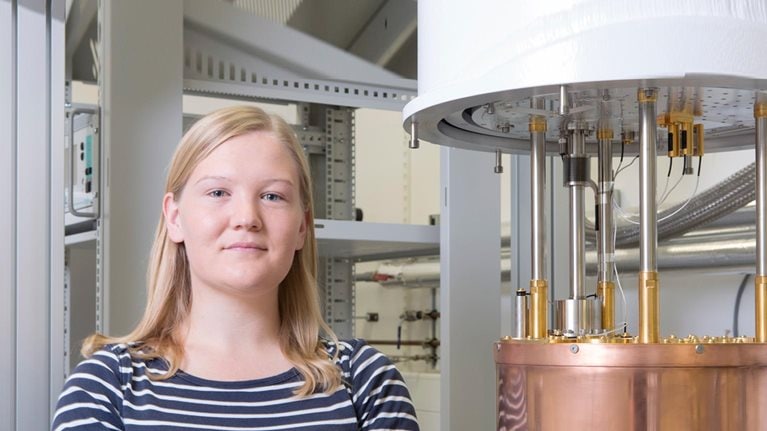Strength of purpose. Optimism for the future. Openness to innovation. These are the tenets that have driven the pharmaceutical company Boehringer Ingelheim’s global growth and breakthrough therapies for more than a century. Today this family-owned company is setting its sights on the next generation of medicines for saving and improving lives. To achieve its goals, the company’s leaders are investing in the next generation of technology: quantum computing.
We spoke to Clemens Utschig-Utschig, Boehringer Ingelheim’s chief technology officer, to learn more about the company’s work to build a dedicated quantum computing lab to explore this emerging technology’s game-changing potential for drug discovery. In our interview, Utschig-Utschig offers insights into building a quantum practice in these early days, including securing funding and support, recruiting and empowering in-house quantum talent, and developing a partner strategy. An edited version of the interview follows.
McKinsey: What are Boehringer Ingelheim’s goals for the coming decade, and how might quantum computing help you achieve them?
Clemens Utschig-Utschig: Our purpose, “transforming lives for generations,” captures our goal quite well. We’re always on the hunt for innovative treatments that save lives, reduce the impact that diseases have on patients, and address population-threatening diseases. And we believe quantum computing, next to all the other technologies we already make use of, such as machine learning, will help us discover and develop better drugs. We know it will be a long journey; there’s still so much work to be done to make quantum computing viable. But science is often made up of evolutionary steps, and we need to invest in the 10,000 small steps that will propel those important discoveries.
McKinsey: What is the current status of quantum computing for pharmaceutical R&D?
Clemens Utschig-Utschig: The work of the past two years at Boehringer Ingelheim and across industry and academia has shown that we need a lot more basic research. One prominent example is the work we did together with Google Quantum AI on estimating the quantum computing resources and runtime it would take to calculate the ground state energy of P450, a very prominent enzyme. Even with the most advanced quantum algorithms, we end up at a time of more than three days, which, even if the hardware were available, is too long to be useful in any real-world pharmaceutical setting. So while we are convinced that this technology can change the ways we do discovery research, progress on quantum computing and industry applicability can be made only if academia and industry join forces.
McKinsey: Given that the technology is still evolving, how did you secure funding and support from the company’s board to invest in quantum use cases?
Clemens Utschig-Utschig: I think it was the right time to meet the right opportunity and vision. Before we approached the board, we knew that to succeed we would need this to be a combined effort by R&D and IT, and so together we discussed what opportunities might exist: Where were we already working with quantum chemistry that would be natural candidates for expansion? Where were we pushing classical methods, such as machine learning and high-performance computing, to their limits? We agreed that the initial goal with quantum would be to look at use cases around how drugs could bind better to their targets. This is one of the holy grails in the pharmaceutical industry. The better a drug binds, the lower the eventual human dose is, and this also translates into fewer side effects for patients. This collaborative approach helped us build significant support from the outset and enabled us to bring in one board member with responsibility for the innovation unit early in the conversation.
When we formally presented to the board, we connected the work to the company’s purpose to save and improve lives and talked about the possibilities in terms of our strategic business priorities. We were up front about the nature of the technology. We told our board it would be a decade before it would unfold. We had ten minutes to present and five minutes of Q&A—almost a venture capital–like pitch without the business case. But because we could connect the possibilities with our purpose, we could make a compelling case for the work and received their support.

Pharma’s digital Rx: Quantum computing in drug research and development
McKinsey: With the board mandate in place, where did you start?
Clemens Utschig-Utschig: We knew at the outset that we would need a quantum computing lab here at Boehringer Ingelheim as the core kernel for exploring how quantum algorithms could advance drug discovery. To build our team internally, we assembled a task force that included HR experts worldwide. Together we created a list of the types of expertise and backgrounds required to successfully build quantum algorithms from the ground up in the areas we initially outlined. This included quantum chemistry and quantum computing expertise, along with a mixture of experience in the design of quantum algorithms, the identification of viable use cases, and venture capital funding (which could provide a view into the evolving world of quantum partnerships). We also wanted a mixture of academic backgrounds—for building scientific connections with universities—and applied experiences, such as experts from quantum computing companies who were involved in creating the technology and had experience building a quantum lab. We spent about nine months assembling the initial team of five people who would bring the right combination of skills.
McKinsey: With great demand for quantum experts today, how do you attract and retain talent for your quantum lab?
Clemens Utschig-Utschig: The market is extremely hot, and you’re competing against big tech companies and well-funded start-ups worldwide. We emphasize our strong purpose and great freedom; that has been our sweet spot for attracting and retaining the talent we need. The purpose is that we work on practical use cases that will have a direct impact on patient lives. Our researchers are passionate about applying their quantum computing knowledge to contribute to this goal. And we provide the freedom to work remotely and make bold decisions to drive our discovery. After we hired the first two people on the team, we gave them the reins to fill the remaining positions, and it’s the team that decides what problems to work on to solve the questions ahead of us.
It also helped that people saw we were serious about quantum. We partnered with Google Quantum AI very early on and were the first pharmaceutical company in the world to do so, and candidates took notice of our commitment and investment.
McKinsey: How did you decide to pursue a partnering approach as part of your quantum strategy, and what other avenues have you explored?
Clemens Utschig-Utschig: There’s only so much you can do internally, and the world is connected, so we are also looking for partners that share our vision. We look for those that can cover everything from the hardware all the way to quantum chemistry knowledge. When identifying our talent needs, we pick partnerships based on the use cases we have. Following the initial Google partnership, it was the team that chose the right additional partners based on their work and previous experience.
Today we are also partnering with start-ups to bridge the gap between classical computational chemistry, quantum chemistry, and quantum computing. And we’re working with a number of universities. For instance, we have a research alliance with the University of Toronto where we are developing new techniques for simulating molecular dynamics and probing reaction mechanisms on quantum computers.
McKinsey: What does an average day look like in your quantum lab?
Clemens Utschig-Utschig: Every day begins with a stand-up team meeting to share status updates. After that, we spend one or two hours together online delving into research papers and other materials—we call these scientific sessions. Then everyone gets down to their own work: coding algorithms, reading new research, evaluating what resources we’ll need, and writing up our conclusions in scientific papers. Whenever someone has a breakthrough, they share their knowledge with the rest of the team. Importantly, we use an open-science approach where we share failures as well as successes.
Every day we’re upskilling ourselves. There are new advancements, and we need to understand what exists in quantum computing and what is still needed. This is just what you have to be prepared for when you’re in this game. I am very hopeful that, by the end of the decade, the physical compute resources that we need will be ready. Today it’s still more a physical problem than an engineering one. It’s a hunt for this logical qubit, and figuring out how we run code, error-correct it, and make it scalable. We’ve run, for instance, extensive simulations to understand how we make quantum useful for drug discovery. And based on that research, it’s clear we need a certain minimum level of resources—in this case, circuit depth. Now we tell vendors, “Here’s our research, and don’t bother coming to us if you can’t provide the circuit depth we need.”
McKinsey: What advice would you give to others just starting their quantum journey?
Clemens Utschig-Utschig: The first thing is to align the work to your purpose. You’ll have a much easier stance getting support if the effort is tied to your purpose and the real business problems your organization wants to solve. Be serious about your investment. This is a deep tech bet and will require both true quantum talent and partnerships to be successful. You also need to be prepared for the realities and rigors of scientific research. You need to give people freedom to explore ideas and learn every day, and truly empower them to make decisions and change direction. That’s when the magic happens. If you try to run quantum teams like an operational show, you’re not going to succeed.


